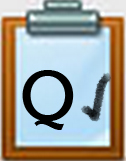Q4. Prototypes Introduction
Introduction
In this Quest, you will create a prototype (an object, a media element, a visual, a presentation) to test your idea and convey it to others. It should be something that can be heard, held, or seen. Remember that a prototype does not need to be pretty or functional to convey your idea.
I Can Statements
- research and cite sources for inspiration for your design
- create a prototype to convey key features of your design
- select appropriate resources for creating a prototype
Play the video "What is Prototyping" (1:17) before continuing to the next step.
What is Prototyping (1:17)
Competencies & Standards
MITECS Michigan Integrated Technology Competencies for Students, and
1. Empowered Learner
a. Articulate and set personal learning goals, developing strategies leveraging technology to achieve them, and reflect on the learning process itself to improve learning outcomes
d. Understand the fundamental concepts of technology operations, demonstrate the ability to choose, use and troubleshoot current technologies and are able to transfer their knowledge to explore emerging technologies
2. Digital Citizen
b. Engage in positive, safe, legal and ethical behavior when using technology, including social interactions online or when using networked devices
c. Demonstrate an understanding of and respect for the rights and obligations of using and sharing intellectual property
3. Knowledge Constructor
a. Plan and employ effective research strategies to locate information and other resources for their intellectual or creative pursuits
b. Evaluate the accuracy, perspective, credibility and relevance of information, media, data or other resources
c. Curate information from digital resources using a variety of tools and methods to create collections of artifacts or solving authentic problems
d. Build knowledge by actively exploring real-world issues and problems, developing ideas and theories and pursuing answers and solutions
4. Innovative Designer
a. Know and use a deliberate design process for generating ideas, testing theories, creating innovative artifacts or solving authentic problems
b. Select and use digital tools to plan and manage a design process that considers design constraints and calculated risks
c. Develop, test and refine prototypes as part of a cyclical design process
d. Exhibit a tolerance for ambiguity, perseverance and the capacity to work with open-ended problems
6. Creative Communicator
a. Choose the appropriate platforms and tools for meeting the desired objectives of their creation or communication
b. Create original works or responsibly repurpose or remix digital resources into new creations
Websites and Documents
Videos from Outside Sources
- Folding Wheel-Morph Wheel YouTube {00:59)
- Our First Grip Buddy Prototype YouTube Short
- Rapid Prototyping Sketching YouTube Short
- What is Prototyping YouTube (1:17)
21t4s Websites
- 9.Q4 Citing Your Source
- Thing 9: Search Strategies: Q1 Michigan eLibrary
- Thing 9: Search strategies: Q2 Safe Searching
21t4s Documents & Quizzes




